Surgeon/Rabbit Fish
Surgeonfishes, family Acanthuridae, have thin, oval bodies, with continuous dorsal
fins, crescent tails, and small mouths. Their name drives from the scalpel-sharp
spine located on each side of the body at the base of the tail. This spine is
used to defend territory or to fight for social dominance. These are not fish to
be handled by divers! Included in this family are the surgeonfishes, tangs,
bristletooth fish, and unicornfish.
| The White-Spotted Surgeonfish Acanthurus
guttatus is not very common in French Polynesia, and we first identified
it on a small reef off the town of Fare, Huahine, in somewhat murky water.
It is characterized by white spots on the rear of the body with two white bars on
body and behind the eye. Also note the yellow ventral fin and foretail.
They grow to about 1 foot (29 cm), and are solitary or in small groups
in shallow surge. (Huahine, Fr. Polynesia) |
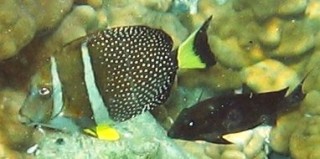 |
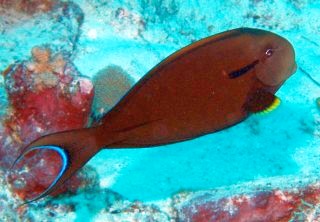 These two surgeonfish look remarkably similar, except for the white
tail ring on the fish on the right. They were, however, photographed in
different oceans and are two different species - albeit very similar
ones.
These two surgeonfish look remarkably similar, except for the white
tail ring on the fish on the right. They were, however, photographed in
different oceans and are two different species - albeit very similar
ones.The range of the Blackstreak Surgeonfish Acanthurus
nigricaudus, left, extends all the way from East Africa to French
Polynesia. It's characterized by a thick black stripe behind the eye and
a thinner one extending forward from the tail spine. It's brown to gray,
with an orange-tinted dorsal fin and yellow on the rear of the pectoral
fins. The blue-white fringe of the tail is quite noticeable, though this
characteristic is on many other surgeonfish as well. (Tonga)
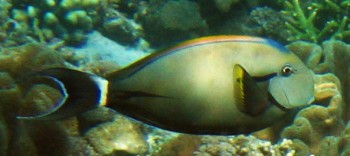 The Eye-stripe Surgeonfish Acanthurus nigricauda
(right) is in our Maldives fish book. The stark white tail-ring is very
noticeable, though this feature is in other surgeonfish as well. As with
the Blackstreak Surgeonfish, its major characteristics are the eye
stripe and thinner tail stripe. The blue forehead shows up in this
picture but is not always so visible.
The Eye-stripe Surgeonfish Acanthurus nigricauda
(right) is in our Maldives fish book. The stark white tail-ring is very
noticeable, though this feature is in other surgeonfish as well. As with
the Blackstreak Surgeonfish, its major characteristics are the eye
stripe and thinner tail stripe. The blue forehead shows up in this
picture but is not always so visible.
Now look at the two Latin names - A. nigricauda and A. nigricaudus.
Very similar. But not the same fish. |
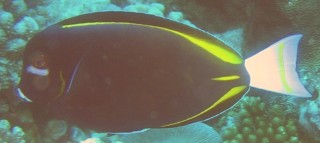 |
The Whitecheek Surgeonfish Acanthurus nigricans is lovely with its golden stripes,
white tail, blue-white lip and white cheek spot. They are solitary or in
small groups both on outer reefs and inside lagoons. (Moorea, Fr.
Polynesia) |
|
This Bluelipped Bristletooth Ctenochaetus
cyanochilus is part-way from its all-yellow
juvenile phase to its adult phase when the tail will darken to match the
rest of the body. The narrow yellow ring around the eye is
characteristic of the adult, as well as the yellow spots on the head and
the blue lines on the orange-brown body. While the Reef Fish book
(Allen, Steene, et al) listed them as occurring from Indonesia to Samoa,
and S. Japan to Australia, this specimen was definitely in the Society
Islands of Fr. Polynesia. (Moorea) |
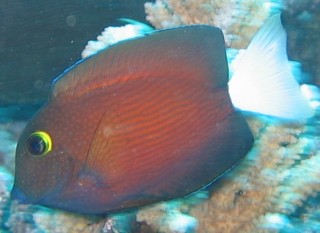 |
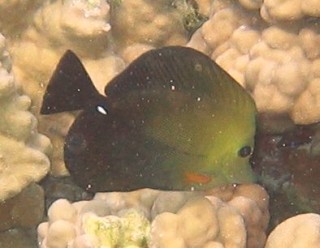
Inside the Tahiti lagoon we came upon this adult Brushtail Tang
Zebrasoma scopas. Although it looks like a trick of the light, this fish really does
change from a yellow-brown head to a dark, almost black tail. The white
tail spine is most noticeable. These fish are solitary or in small
groups to 50 m. (Society Islands, Fr. Polynesia) |
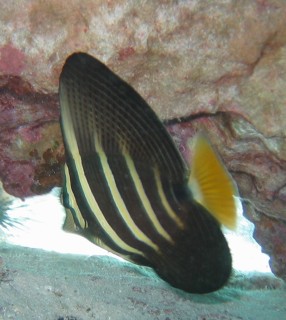
The Pacific Sailfin Tang Zebrasoma veliferum is a lovely fish with its
enlarged dorsal fin and alternating bars of yellow and brown. The tail
can be white to yellow to brown. This shot is possibly of a fish
intermediate between the very yellow juvenile and the adult which has
less obvious bars towards the tail. We have seen these fish in Bora
Bora, Fr. Polynesia, and later in Tonga. (Society Islands, Fr. Polynesia) |
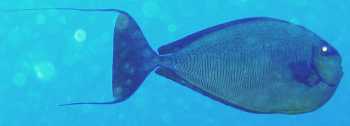 |
This Bignose Unicornfish Naso vlamingii (dark phase) was at about
35-50' (10-15 meters) depth on the outer reef of Moorea. Like many fish when they are
being photographed, they tend to turn tail and swim away! With low
light, it is often the shape of the fish which helps with its
identification. By enhancing the photos on the computer when we return
we can get more detail, as we did with this one. (Moorea, Fr. Polynesia) |
Rabbitfish (family Siganidae) are not related to Surgeonfish, but are
similarly shaped and equally colorful. They are grazers like Surgeonfish and
Parrotfish, and help to keep the algae on
rock surfaces down to only a millimeter or two in length. The dorsal, ventral,
and anal spines of Rabbitfish are mildly venomous but extremely painful, which earned
them their ironic Australian name of 'Happy Moments'. With the exception of the
Java Rabbitfish (not shown) which can grown to over 50 cm and which we saw in
Thailand, a typical adult size is 25 to 30 cm (about 10 to 12 inches).
 |
The Masked Rabbitfish Siganus puellus (left)
has a singular black mask over the eye descending to the lips. The body
is yellow with vertical lines near the head and horizontal lines from
mid-body back. They feed on tunicates and sponges and are found in the
Western Pacific from Japan to the Great Barrier Reef, and from
Micronesia to Indonesia. (Lizard Island, Great Barrier Reef) Barred
Rabbitfish Siganus doliatus (right) are blue-white with fine
yellow and blue lines. They may be in pairs or small schools, in 2
to 15 meters. (Lizard island, Grt B. Reef) |
 |
 |
Coral Rabbitfish Siganus corallinus (left) are bright
yellow with many small blue dots and a dark eye blotch. The young
congregate in schools in sea grass, while adults can be found in
coral-rich areas in pairs to a depth of 18 meters. (Lizard Island, Great
Barrier Reef)
Foxface Rabbitfish Siganus vulpinus (right) are found in the
western Pacific from Indonesia to the Gilbert Islands. They often
shelter in staghorn corals to a depth of 30 m. (Lizard Island, Great
Barrier Reef) |
 |
Up | Nudibranchs | Coral Reef | Venomous Animals | Angelfish | Butterflyfish | Damselfish | Puffers | Sharks & Rays | Snappers & Breams | Surgeon/Rabbit Fish | Triggerfish | Wrasse & Parrotfish | Other Reef Fish
Reef Animals | UW Photo How-to | Scuba Diving
Top Level:
Home |
Destinations |
Cruising Info |
Underwater |
Boat Guests |
Ocelot |
Sue |
Jon |
Amanda |
Chris |
Site Map |
Make a Comment
 |
Lifetime
Commodores
of the
Seven Seas
Cruising
Association |
 |
|
If our information is useful,
you can help by making a donation
|
Copyright © 2000‑ Contact:
Jon and Sue Hacking -- HackingFamily.com, svOcelot.com.
All rights reserved.

